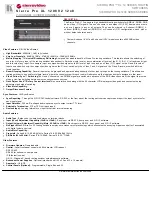
C
HAPTER
1
| Introduction
Description of Software Features
– 71 –
C
ONFIGURATION
B
ACKUP
AND
R
ESTORE
You can save the current configuration settings to a file on the
management station (using the web interface) or an FTP/TFTP server
(using the web or console interface), and later download this file to restore
the switch configuration settings.
A
UTHENTICATION
This switch authenticates management access via the console port, Telnet,
or a web browser. User names and passwords can be configured locally or
can be verified via a remote authentication server (i.e., RADIUS or
). Port-based authentication is also supported via the IEEE
802.1X protocol. This protocol uses Extensible Authentication Protocol over
LANs (EAPOL) to request user credentials from the 802.1X client, and then
uses the EAP between the switch and the authentication server to verify
the client’s right to access the network via an authentication server (i.e.,
RADIUS or server).
Other authentication options include HTTPS for secure management access
via the web, SSH for secure management access over a Telnet-equivalent
connection, SNMP Version 3, IP address filtering for SNMP/Telnet/web
management access. MAC address filtering and IP source guard also
provide authenticated port access. While DHCP snooping is provided to
prevent malicious attacks from insecure ports. While PPPoE Intermediate
Agent supports authentication of a client for a service provider.
A
CCESS
C
ONTROL
L
ISTS
ACLs provide packet filtering for IP frames (based on address, protocol,
TCP/UDP port number or TCP control code) or any frames (based on MAC
address or Ethernet type). ACLs can by used to improve performance by
blocking unnecessary network traffic or to implement security controls by
restricting access to specific network resources or protocols.
P
ORT
C
ONFIGURATION
You can manually configure the speed, duplex mode, and flow control used
on specific ports, or use auto-negotiation to detect the connection settings
used by the attached device. Use full-duplex mode on ports whenever
possible to double the throughput of switch connections. Flow control
should also be enabled to control network traffic during periods of
congestion and prevent the loss of packets when port buffer thresholds are
exceeded. The switch supports flow control based on the IEEE 802.3x
standard (now incorporated in IEEE 802.3-2002).
R
ATE
L
IMITING
This feature controls the maximum rate for traffic transmitted or received
on an interface. Rate limiting is configured on interfaces at the edge of a
network to limit traffic into or out of the network. Packets that exceed the
acceptable amount of traffic are dropped.
P
ORT
M
IRRORING
The switch can unobtrusively mirror traffic from any port to a monitor port.
You can then attach a protocol analyzer or RMON probe to this port to
perform traffic analysis and verify connection integrity.
Summary of Contents for ECS3510-10PD
Page 1: ...Management Guide www edge core com 10 Port Layer 2 Fast Ethernet Switch...
Page 2: ......
Page 4: ......
Page 48: ...CONTENTS 48...
Page 68: ...SECTION I Getting Started 68...
Page 78: ...CHAPTER 1 Introduction System Defaults 78...
Page 96: ...CHAPTER 2 Initial Switch Configuration Managing System Files 96...
Page 98: ...SECTION II Web Configuration 98...
Page 118: ...CHAPTER 3 Using the Web Interface Navigating the Web Browser Interface 118...
Page 150: ...CHAPTER 4 Basic Management Tasks Resetting the System 150...
Page 196: ...CHAPTER 5 Interface Configuration VLAN Trunking 196 Figure 66 Configuring VLAN Trunking...
Page 238: ...CHAPTER 7 Address Table Settings Configuring MAC Address Mirroring 238...
Page 264: ...CHAPTER 8 Spanning Tree Algorithm Configuring Interface Settings for MSTP 264...
Page 274: ...CHAPTER 9 Congestion Control Automatic Traffic Control 274...
Page 288: ...CHAPTER 10 Class of Service Layer 3 4 Priority Settings 288...
Page 304: ...CHAPTER 11 Quality of Service Attaching a Policy Map to a Port 304...
Page 424: ...CHAPTER 13 Security Measures DHCP Snooping 424...
Page 568: ...CHAPTER 14 Basic Administration Protocols OAM Configuration 568...
Page 596: ...CHAPTER 15 IP Configuration Setting the Switch s IP Address IP Version 6 596...
Page 614: ...CHAPTER 1 IP Services Configuring the PPPoE Intermediate Agent 614...
Page 784: ...CHAPTER 20 System Management Commands Powered Device 784...
Page 814: ...CHAPTER 22 Remote Monitoring Commands 814...
Page 1008: ...CHAPTER 26 Interface Commands Power Savings 1008...
Page 1022: ...CHAPTER 27 Link Aggregation Commands Trunk Status Display Commands 1022...
Page 1052: ...CHAPTER 29 Congestion Control Commands Automatic Traffic Control Commands 1052...
Page 1064: ...CHAPTER 31 UniDirectional Link Detection Commands 1064...
Page 1070: ...CHAPTER 32 Address Table Commands 1070...
Page 1130: ...CHAPTER 34 ERPS Commands 1130...
Page 1172: ...CHAPTER 35 VLAN Commands Configuring Voice VLANs 1172...
Page 1186: ...CHAPTER 36 Class of Service Commands Priority Commands Layer 3 and 4 1186...
Page 1302: ...CHAPTER 38 Multicast Filtering Commands MVR for IPv6 1302...
Page 1368: ...CHAPTER 40 CFM Commands Delay Measure Operations 1368...
Page 1390: ...CHAPTER 42 Domain Name Service Commands 1390...
Page 1448: ...CHAPTER 44 IP Interface Commands ND Snooping 1448...
Page 1450: ...SECTION IV Appendices 1450...
Page 1455: ...APPENDIX A Software Specifications Management Information Bases 1455 UDP MIB RFC 2013...
Page 1456: ...APPENDIX A Software Specifications Management Information Bases 1456...
Page 1482: ...COMMAND LIST 1482...
Page 1493: ......
















































